May 8, 2023 | pedestrian accident Claims
Can a Child Be Contributorily Negligent?
Table of Contents
From a very young age, children are taught to always look both ways before crossing the road. Pedestrians are the most vulnerable road users and the most likely to be severely injured or killed as the result of a collision caused by a careless driver. That is why it is so important to teach children about personal safety precautions.
Learning to look out for approaching vehicles before entering a crosswalk or jogging across the street is an essential part of growing up. But should a child’s future be jeopardized if they fail to do so?
In most motor vehicle accident claims, in order to recover compensation through tort action, the injured Plaintiff is required to prove that the Defendant was negligent and that their negligence was directly responsible for their injuries. For example, an injured car accident survivor must be able to present evidence proving that the at-fault driver engaged in wrongful conduct behind the wheel that ultimately led to their injury-causing collision.
In certain provinces, this rule even applies to cases where pedestrians have been struck by a motor vehicle. That means that if a person is hit by a car, that person will need to present evidence proving that the injuries they sustained were caused by the driver’s wrongful actions.
However, in Ontario, there is a reverse onus on drivers who are involved in motor vehicle collisions with pedestrians. This means that if a driver strikes a pedestrian with their vehicle, there is a presumption of fault against the driver, unless they can prove otherwise. One of the most common ways drivers try to alleviate themselves of this liability is by trying to prove the pedestrian’s contributory negligence.
What Is Contributory Negligence?
If the wrongful actions or inactions of a pedestrian contribute to the conditions that cause a collision with a motor vehicle to occur, the pedestrian might be considered to be contributorily negligent. This contributory negligence could be taken into consideration when determining compensation for their injuries in a civil claim.
According to Ontario’s Negligence Act, a pedestrian who contributes to their own injuries can still recover damages from the at-fault driver or their insurance company. However the amount of compensation may be reduced based on the degree to which the accident was the pedestrian’s fault.
For example, if a pedestrian is illegally jaywalking or crossing the street against a traffic signal and is hit by a car as a result of their wrongful conduct, the damages to which an injured pedestrian is entitled may be reduced.
But what happens if a child is struck by a vehicle because they neglected to look both ways before crossing the street? Could this injured child’s actions be considered contributory negligence? Should the damages they are able to receive be reduced because of their unintentional actions?
Recent Case Study
A recent decision by the Superior Court of Ontario provides some further insights into this issue. In Serravalle v. Duggan, 2023 ONSC 933, the Court examined the role of contributory negligence in the context of a pedestrian accident involving a minor.
Audrey Serravalle, an 11-year-old girl from Pelham, Ontario, sustained permanent and severe injuries when she was hit by a vehicle while crossing the road to collect her family’s mail from a mailbox. A garbage truck was parked near the mailbox. The at-fault driver tried to pull ahead in front of the parked truck, hitting the minor on her way to the mailbox.
As a result of the collision, Audrey sustained severe injuries, including a serious and permanent impairment of her left foot. The injuries limited her residual earning capacity to sedentary employment in the future.
Facing a civil claim for Audrey’s damages, the owner and operator of the garbage truck and the driver who struck her filed a counterclaim against Audrey’s parents for not supervising or instructing the child adequately. The operator of the motor vehicle that struck Audrey claimed the minor was entirely responsible for the accident as he was unable to avoid a collision with her when she entered the road.
Although the Court acknowledged that Audrey’s actions might have contributed to the factors leading to her injury-causing accident, it could find no discussion on the law concerning contributory negligence in a pedestrian accident involving a child or any reference to case law setting precedents for how damages in such situations should be assessed. Given the lack of guidance and formal method for assessment, each scenario must be decided on a case-by-case basis.
The Court explained that the reasonableness of the minor’s behaviour should be evaluated based on their age, intelligence, and experience. Insofar as one could reasonably expect an 11-year old child to exercise caution before running into the street, this fact does not discount or disprove the actual negligence of the at-fault parties.
In its evaluation of the Defendants’ liability, the Court found that the garbage truck driver breached the Highway Traffic Act by blocking most of the lane. The Court also found ample evidence suggesting that the vehicle operator was negligent, and that the owners of the garbage truck company could potentially be found negligent, as well.
How An Ontario Pedestrian Accident Lawyer May Be Able To Help
If a driver is able to prove that a pedestrian’s contributory negligence was partially responsible for their injuries, the pedestrian may still be able to recover damages. However, the amount they receive may be reduced in proportion to their degree of fault.
That said, in the province of Ontario, there is a presumption of negligence on the part of any motorist who strikes a pedestrian. There is a reverse onus of proof on the operator of a vehicle involved in a pedestrian accident to demonstrate that they were not at fault for striking the pedestrian.
If you or your child have been involved in an injury-causing collision caused by a negligent driver, our Ontario pedestrian accident lawyers may be able to help you defend your rights and get the compensation you deserve. To schedule a free initial consultation and learn about options that might be available to you, contact us today.
Blog Categories
More pedestrian accident Topics
Here’s more information on pedestrian accident related topics that we think you might find helpful.

bicycle accident
|
January 11, 2023
Toronto’s Most Dangerous Intersections for Accidents
Over the last few years, as pandemic restrictions in Toronto have eased and the pace of life began returning to normal, residents of the city…

ATV accident
|
November 10, 2017
Contributory Negligence in Toronto Injury Cases
If you were involved in an accident for which you were partially at fault, it is still possible to recover compensation for your damages. However,…
Speak With Our
Legal Team for FREE
Find Out if You Have a Case in Under 5 Minutes
Speak to a Lawyer Now!
We’re here to help.
